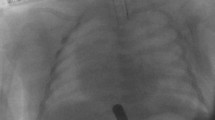Abstract
Circular esophageal myotomy (CEM) is currently a well-accepted technique for elongation of the upper esophageal pouch in cases of long-gap esophageal atresia (EA). Esophageal pseudodiverticulum is a frequent and perhaps underreported sequela of this technique, characterized by ballooning or outpouching of the esophageal mucosa in the myotomized area. The present study was designed to seek a supplement for the CEM technique in order to avoid possible pseudodiverticulum formation in the myotomized area. We created an animal model to simulate the anatomic conditions present after primary repair of EA facilitated by CEM. Three groups of dogs underwent either cervical (1 group) or thoracic (2 groups) esophageal myectomy. In the cervical and first thoracic groups, the denuded mucosa was left without any support. In the second thoracic group, the denuded mucosal area was wrapped with polyglactin 910 (Vicryl) mesh. In all three groups the esophagus was narrowed by a Marlex mesh ring 3 cm distal to the myectomized zone, simulating a condition resulting from anastomotic narrowing. The dogs underwent barium swallows under fluoroscopy at different postoperative periods and were killed 4 or 6 months after surgery. The esophagi were removed for gross and radiologic investigation under maximal insufflation as well as for histologic assessment. The proposed canine model proved to be useful for study of the myectomized esophagus, mimicking the anatomy and conditions after CEM in long-gap EA repair. Wrapping the denuded mucosa with Vicryl mesh fortified the weakened esophageal wall, thus diminishing the likelihood of future pseudodiverticulum development. In light of the simplicity of the technique and the absence of any evident risk or complications, we recommend that the use of Vicryl mesh wrap be considered during CEM to reinforce the esophageal wall.
Similar content being viewed by others
References
Carveth SW, Schlegel JF, Code CF, Ellis FH Jr (1962) Esophageal motility after vagotomy, phrenicotomy, myotomy, and myomectomy in dogs. Surg Gynec Obst 114: 31–42
De Lorimier A, Harrison M (1980) Long gap esophageal atresia. Primary anastomosis after esophageal elongation by bougienage and esophagomyotomy. J Thorac Cardiovasc Surg 79: 138–141
Ein SH, Shandling B, Heiss K (1993) Pure esophageal atresia: outlook in the 1990's. J Pediatr Surg 28: 1147–1150
Janik JS, Filler RM, Ein SH, Simpson JS (1980) Long-term follow-up of circular myotomy for esophageal atresia. J Pediatr Surg 15: 835–841
Kontor EJ (1975) Esophageal atresia with wide gap: primary anastomosis following Livaditis procedure. J Pediatr Surg 11: 583–584
Kralik J, Vojacek K, Skibbe G (1969) Morphologische und funktionelle Folgen der segmentalen Myektomie der Speiserbhre im Tierversuch (Langenbecks). Arch Clin Chir 326: 38–46
Livaditis A (1973) Esophageal atresia: a method of overbridging large segmental gaps. Z Kinderchir 13: 298–306
Livaditis A, Bjork G, Kangstrom LE (1969) Esophageal myecotomy: an experimental study in piglets. Scand J Thorac Cardiovasc Surg 3: 181–185
Livaditis A, Radberg L, Odensjo G (1972) Esophageal end-to-end anastomosis: reduction of anastomosic tension by circular myotomy. Scand J Thorac Cardiovasc Surg 6: 206–214
Muangsombut J, Hankins JR, Mason GR, et al (1974) The use of circular myotomy to facilitate resection and end-to-end anastomosis of the esophagus. J Thorac Cardiovasc Surg 68: 522–529
Otte JB, Gianello P, Wese FX, Claus D, Verellen G, Moulin D (1984) Diverticulum formation after circular myotomy for esophageal atresia. J Pediatr Surg 19: 68–71
Potter SE, Holyoke EA (1950) Observations on the intrinsic blood supply of the esophagus. Arch Surg 61: 944–949
Schlegel JF, Code CF (1958) Pressure characteristics of the esophagus and its sphincters in dogs. Am J Physiol 193: 9–14
Schneeberger AL, Scott RB, Rubin SZ, Machida H (1987) Esophageal function following Livaditis repair of long gap esophageal atresia. J Pediatr Surg 22: 779–783
Shakespeare W. The tragedy of King Lear. Act 1, Sc 4, line 353. The signet classic - Penguin Books (1987) New York, USA
Siegel MJ, Shackelford GD, McAlister WH, et al (1980) Circular oesophageal myotomy simulating a pulmonary or mediastinal pseudocyst. Radiology 136: 365–368
Vizas D, Ein SH, Simpson JS (1978) The value of circular myotomy for esophageal atresia. Pediatr Surg 13: 357–359
Author information
Authors and Affiliations
Additional information
Supported by the Slezak Fund for Experimental Surgery (Grant #01370791)
Rights and permissions
About this article
Cite this article
Freud, E., Blumenfeld, A., Zer, M. et al. Use of Vicryl mesh to support the esophageal wall after circular myotomy (Livaditis procedure) in long-gap esophageal atresia — an experimental study. Pediatr Surg Int 11, 539–543 (1996). https://doi.org/10.1007/BF00626061
Accepted:
Published:
Issue Date:
DOI: https://doi.org/10.1007/BF00626061




